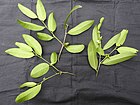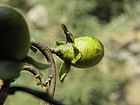Note: This is a project under development. The articles on this wiki are just being initiated and broadly incomplete. You can Help creating new pages.
Difference between revisions of "Diospyros ebenum"
(Created page with "{{stub}} ==Uses== {{Uses|}}, {{Uses|}}, {{Uses|}}, {{Uses|}}, {{Uses|}}, {{Uses|}}, {{Uses|}}, {{Uses|}}, {{Uses|}}, {{Uses|}}, {{Uses|}}.<ref name="Uses"/> ==Parts Used== {...") |
|||
| (4 intermediate revisions by the same user not shown) | |||
| Line 1: | Line 1: | ||
| − | + | [[File:Diopyros ebenum-3-JNTBGRI-palode-kerala-India.jpg|thumb|right]] | |
| − | + | '''Diospyros ebenum''' is a slow-growing, medium-sized, evergreen tre. It can grow up to 30 metres tall. The straight bole can be 90cm in diameter, with buttresses that are up to 2 metres high. | |
==Uses== | ==Uses== | ||
| − | {{Uses| | + | {{Uses|Blistering plaster}}. |
==Parts Used== | ==Parts Used== | ||
| − | {{Parts Used| | + | {{Parts Used|Fruits}}. |
==Chemical Composition== | ==Chemical Composition== | ||
| Line 17: | Line 17: | ||
===Dravya=== | ===Dravya=== | ||
===Rasa=== | ===Rasa=== | ||
| − | |||
===Guna=== | ===Guna=== | ||
| Line 30: | Line 29: | ||
==Habit== | ==Habit== | ||
| − | {{Habit|}} | + | {{Habit|Evergreen tree}} |
==Identification== | ==Identification== | ||
===Leaf=== | ===Leaf=== | ||
| − | {{Leaf|||}}<ref name="Leaf"/> | + | {{Leaf|Simple|Elliptic|Ovate-oblong, Coriaceus, Deoceous}}<ref name="Leaf"/> |
===Flower=== | ===Flower=== | ||
| − | {{Flower||||}} | + | {{Flower|||Pale green in colour|Slightly pubescent outside, Unisexual, Glabrous}} |
===Fruit=== | ===Fruit=== | ||
| Line 49: | Line 48: | ||
==Mode of Propagation== | ==Mode of Propagation== | ||
| − | {{Propagation|}} | + | {{Propagation|Seeds}} |
==How to plant/cultivate== | ==How to plant/cultivate== | ||
| − | <ref name="How to plant/cultivate"/> | + | A plant of comparatively dry areas in the tropics.<ref name="How to plant/cultivate"/> |
==Commonly seen growing in areas== | ==Commonly seen growing in areas== | ||
| − | {{Commonly seen|}}, {{Commonly seen|}}, {{Commonly seen| | + | {{Commonly seen|Humid}}, {{Commonly seen|Lowland forests}}, {{Commonly seen|Dry evergreen forests}}. |
==Photo Gallery== | ==Photo Gallery== | ||
<gallery class="left" caption="" widths="140px" heights="140px"> | <gallery class="left" caption="" widths="140px" heights="140px"> | ||
| − | + | Diopyros ebenum-3-JNTBGRI-palode-kerala-India.jpg | |
| + | Diospyros assimilis from Alaram WLS during the Odonate Survey 2015 (1).jpg | ||
| + | Diospyros assimilis from Alaram WLS during the Odonate Survey 2015 (10).jpg | ||
| + | Diospyros assimilis from Alaram WLS during the Odonate Survey 2015 (11).jpg | ||
| + | Diospyros assimilis from Alaram WLS during the Odonate Survey 2015 (12).jpg | ||
</gallery> | </gallery> | ||
| Line 65: | Line 68: | ||
<references> | <references> | ||
| − | <ref name="chemical composition">[ | + | <ref name="chemical composition">[Chemistry ]</ref> |
| − | <ref name="Leaf"> | + | <ref name="Leaf">Kappatagudda - A Repertoire of Medicianal Plants of Gadag by Yashpal Kshirasagar and Sonal Vrishni, Page No. 168</ref> |
| + | |||
| + | <ref name="How to plant/cultivate">[http://tropical.theferns.info/viewtropical.php?id=Diospyros+ebenum Cultivation]</ref> | ||
| − | |||
| − | |||
</references> | </references> | ||
==External Links== | ==External Links== | ||
| − | * [ ] | + | * [http://tropical.theferns.info/image.php?id=Diospyros+ebenum Diospyros ebenum on theferns.info] |
| − | * [ ] | + | * [https://pfaf.org/user/Plant.aspx?LatinName=Diospyros+ebenum Diospyros ebenum on pfaf.org] |
| − | + | ||
[[Category:Herbs]] | [[Category:Herbs]] | ||
| + | [[Category:Pages without herbs images]] | ||
Latest revision as of 18:22, 5 May 2021
Diospyros ebenum is a slow-growing, medium-sized, evergreen tre. It can grow up to 30 metres tall. The straight bole can be 90cm in diameter, with buttresses that are up to 2 metres high.
Contents
- 1 Uses
- 2 Parts Used
- 3 Chemical Composition
- 4 Common names
- 5 Properties
- 6 Habit
- 7 Identification
- 8 List of Ayurvedic medicine in which the herb is used
- 9 Where to get the saplings
- 10 Mode of Propagation
- 11 How to plant/cultivate
- 12 Commonly seen growing in areas
- 13 Photo Gallery
- 14 References
- 15 External Links
Uses
Parts Used
Chemical Composition
Common names
| Language | Common name |
|---|---|
| Kannada | |
| Hindi | |
| Malayalam | |
| Tamil | |
| Telugu | |
| Marathi | |
| Gujarathi | |
| Punjabi | |
| Kashmiri | |
| Sanskrit | |
| English |
Properties
Reference: Dravya - Substance, Rasa - Taste, Guna - Qualities, Veerya - Potency, Vipaka - Post-digesion effect, Karma - Pharmacological activity, Prabhava - Therepeutics.
Dravya
Rasa
Guna
Veerya
Vipaka
Karma
Prabhava
Habit
Identification
Leaf
| Kind | Shape | Feature |
|---|---|---|
| Simple | Elliptic | Ovate-oblong, Coriaceus, Deoceous |
Flower
| Type | Size | Color and composition | Stamen | More information |
|---|---|---|---|---|
| Pale green in colour | Slightly pubescent outside, Unisexual, Glabrous | {{{5}}} |
Fruit
| Type | Size | Mass | Appearance | Seeds | More information |
|---|---|---|---|---|---|
Other features
List of Ayurvedic medicine in which the herb is used
Where to get the saplings
Mode of Propagation
How to plant/cultivate
A plant of comparatively dry areas in the tropics.[3]
Commonly seen growing in areas
Humid, Lowland forests, Dry evergreen forests.
Photo Gallery
References
- ↑ [Chemistry ]
- ↑ Kappatagudda - A Repertoire of Medicianal Plants of Gadag by Yashpal Kshirasagar and Sonal Vrishni, Page No. 168
- ↑ Cultivation
External Links
Categories:
- Ayurvedic Herbs known to be helpful to treat Blistering plaster
- Herbs with Fruits used in medicine
- Habit - Evergreen tree
- Index of Plants which can be propagated by Seeds
- Herbs that are commonly seen in the region of Humid
- Herbs that are commonly seen in the region of Lowland forests
- Herbs that are commonly seen in the region of Dry evergreen forests
- Herbs
- Pages without herbs images





